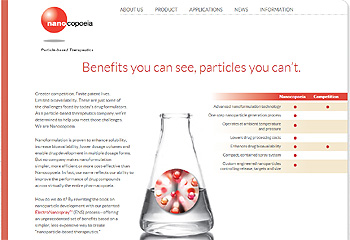Nanocopoeia, Inc., a rapidly-growing nanotechnology company based in St. Paul, has launched its new corporate website, www.nanocopoeia.com.
 Nanocopoeia's new corporate website.
Nanocopoeia's new corporate website.
The new website provides detailed information on the applications and benefits of Nanocopoeia's patented ElectroNanospray platform (ENS), a one step process for the creation of particle-based therapeutics utilized in drug manufacturing, drug delivery and medical device coatings. The technology uses a proprietary electrospray process to produce remarkably uniform nanoparticles.
These particles, ranging in size from 20 - 200 nm, exhibit novel physical, chemical and biological properties compared with larger particles produced by existing industrial processes.
"We are very excited to showcase our unique capabilities with this new website," stated Karen Arnold co-founder and CEO, "We turn nanoparticles into a business by identifying therapeutic and industrial uses for those particles. On the therapeutic side, the potential benefit of drugs that are formulated into nanoparticles include 10-fold or greater improvements in bioavailability, increased speed of action, and the possibility of new, more convenient delivery routes when compared with traditional oral or intravenous administration.
The process we use is also capable of creating engineered coatings for medical and diagnostic devices. This enables a whole new generation of devices that have improved therapeutic and diagnostic capabilities. "
About Nanocopoeia
Nanocopoeia is a drug delivery company developing a nanotechnology-enabled portfolio of therapeutic products. The business of Nanocopoeia is the therapeutic use of those nanoparticles in medical applications. The patented ElectroNanospray (ENS) process is currently being used to produce complex coatings for medical devices and to nanoformulate drugs. The ENS process consistently results in multiple-fold improvements in water solubility, or more precisely, "nanoscale suspendability." ENS is used to create either bare drug nanoparticles or coated, core:shell nanoparticles in a single, "bottom up" processing step rather than a multi-step "top down" process.